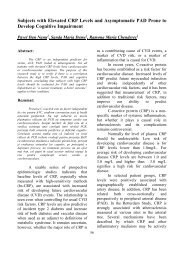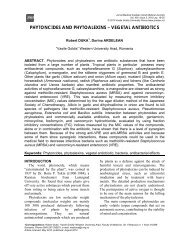PROFUNDOPLASTY - A SOLUTION FOR DISTAL ...
PROFUNDOPLASTY - A SOLUTION FOR DISTAL ...
PROFUNDOPLASTY - A SOLUTION FOR DISTAL ...
Create successful ePaper yourself
Turn your PDF publications into a flip-book with our unique Google optimized e-Paper software.
Jurnal Medical Aradean (Arad Medical Journal)<br />
Vol. XIII, issue 4, 2010, pp. 67-70<br />
© 2010 Vasile Goldis University Press (www.jmedar.ro)<br />
<strong>PROFUNDOPLASTY</strong> - A <strong>SOLUTION</strong> <strong>FOR</strong> <strong>DISTAL</strong><br />
REVASCULARIZATIONS<br />
Bogdan TOTOLICI 1 , Mircea ALEXA 1 , Daniel CIURDARIU 2<br />
1 Clinical Emergency County Hospital Arad, Romania<br />
2 Genesys Hospital Arad, Romania<br />
ABSTRACT. The deep femoral artery is the main source of blood supply to the leg and foot when<br />
the superficial femoral artery is occluded. In this situation, the geometry of the trunk of the deep<br />
femoral artery represents a stenosis of 50 per cent interposed between the common femoral artery<br />
and the collateral circuit of the deep femoral artery. Profundoplasty indications vary depending on<br />
its use as isolated or adjunctive procedure. As an adjunctive procedure profundoplasty is performed<br />
in all cases of ischemia, including critical limb ischemia. It's essential to restore outflow when the<br />
superficial femoral is occluded. Profundplasty is still a valuable option for patients with femoral<br />
PAD and claudication without tissue loss. It is a straightforward procedure that combines good<br />
efficacy with low complication rates. Further endovascular treatment may be facilitated. It is not<br />
useful for patients with the combination of critical ischemia and tissue loss. Profundoplasty’s<br />
technical facility has the advantage over bypass surgery.<br />
Keywords: profundoplasty, revascularization, claudication<br />
INTRODUCTION<br />
The deep femoral artery is the main source<br />
of blood supply to the leg and foot when the<br />
superficial femoral artery is occluded. In this<br />
situation, the geometry of the trunk of the<br />
deep femoral artery represents a stenosis of 50<br />
per cent interposed between the common<br />
femoral artery and the collateral circuit of the<br />
deep femoral artery. Intimal thickening of<br />
only 0,5 and 1,0 mm increases this anatomic<br />
stenosis to 64 and 76 per cent, respectively.<br />
Beyond the trunk, the cross-sectional area of<br />
the deep femoral artery circuit increases at<br />
each arterial division. Any reconstruction of<br />
the deep femoral artery intended to increase<br />
its inflow must extend down to at least its first<br />
important bifurcation if it is to overcome this<br />
trunk "stenosis" and to carry out an anatomic<br />
bypass alone. This requirement explains the<br />
effectiveness of proper reconstruction of the<br />
deep femoral artery in avoiding or delaying<br />
amputation in patients with ischemic<br />
symptoms and occlusion of the superficial<br />
femoral artery who are not candidates for<br />
femur-popliteal reconstruction. In this case<br />
the absence of high grade stenosis is not a<br />
contraindication.<br />
ANATOMICAL ASPECTS<br />
Typically, PFA (profound femoral artery)<br />
is the main supplier of blood to the leg and<br />
foot. In cases when the superficial femoral<br />
artery and popliteal artery are severely<br />
affected or occluded, PFA is the main<br />
collateral channel to the common iliac artery<br />
and femoral artery to the distal end. The value<br />
of PFA for the viability of ischemic leg was<br />
set and emphasized since 1961, proved to be<br />
an effective alternative to bypass (which is<br />
more laborious). Profundoplasty technique<br />
can be used as an isolated or associated with<br />
other revascularization procedures.<br />
CLASSIFICATION OF<br />
PROFUNDOPLASTIES<br />
Proximal - when it extends to the second<br />
perforant of PFA<br />
Extended - you pass the second perforant<br />
of PFA<br />
*Correspondence: Totolici Bogdan , Emergency Clinical County Hospital, no. 1-3 Victoriei Street., Arad, Romania, e-mail:<br />
secretariat@scj.dntar.ro<br />
Article received: June 2010; published: November 2010
Totolici B., Alexa M., Ciurdariu D.<br />
Fig. 1 Cases of EHP and No EHP<br />
<strong>PROFUNDOPLASTY</strong> INDICATIONS<br />
Profundoplasty indications vary<br />
depending on its use as isolated or adjunctive<br />
procedure.<br />
As an adjunctive procedure is<br />
performed in all cases of ischemia, including<br />
critical limb ischemia.<br />
It's essential to restore outflow when<br />
the superficial femoral is occluded.<br />
The success of profundoplasty is<br />
assured by the existence of a significant injury<br />
to the abundant collateral AFP and popliteal<br />
artery and tibial branches.<br />
Even patients with critical ischemia<br />
benefit from revascularization with<br />
profundoplasty, when other options are<br />
unsuitable (safena vein absent, the clinical<br />
condition does not allow an extended<br />
process).<br />
OPERATIVE TECHNIQUE<br />
The approach of the artery (PFA) is<br />
performed through a vertical incision in the<br />
femoral tripod trigonal Scarpa and aims<br />
entirely (FCA, SFA, PFA).<br />
The gain of control on all colaterals.<br />
Heparinization 3000 - 5000 IU.<br />
Fig. 2 Cases of genital cancer<br />
Arteriotomy started on the AFC to prevent<br />
damage to the posterior wall of AFP and<br />
continued until it meets the normal arterial<br />
wall.<br />
Profundoplasty is frequently done with a<br />
patch without endarterectomy.<br />
Endarterectomy on the PFA is extremely<br />
difficult and risky due to the fragility of the<br />
arterial wall and that is to be avoided.<br />
The patch can be used autogenous (vein) or<br />
adaptive (Dacron, PTFE).<br />
Fixing patch is made from two continuous<br />
surjet monofilament wire ends.<br />
THE EXPERIENCE OF SURGERY<br />
CLINIC OF ARAD CLINICAL<br />
EMERGENCY COUNTY HOSPITAL<br />
We practiced this technique since 2001,<br />
from the moment of establishment of vascular<br />
surgery department.<br />
During 2001-2009 we conducted a total of<br />
143 profundoplasties, a group with a mean<br />
age of 58 years (range 47-82 years) with a<br />
male / female rate of 3 / 1.<br />
From total number of profundoplasties,<br />
only 10 were isolated, the rest being done<br />
adjunctive to bypass.<br />
68<br />
Jurnal Medical Aradean (Arad Medical Journal)<br />
Vol. XIII, issue 4, 2010, pp. 67-70<br />
© 2010 Vasile Goldis University Press (www.jmedar.ro)
Profundoplasty - a solution for distal revascularizations<br />
Fig. 3 Approach areas of the femoral artery and<br />
its branches<br />
Fig. 4 Operative stages<br />
Fig. 5 Adjuvant profundoplasty A<br />
We used the venous patch (from internal<br />
safena) in 8 cases of isolated<br />
profundoplasties.<br />
From total number of profundoplasties<br />
only four required extended technique, in the<br />
rest being enough the proximity technique.<br />
Postoperative results were evaluated by<br />
clinical parameters (pain, claudication, skin<br />
temperature, distal lesions heal) and<br />
paraclinical (systolic pressure index<br />
Fig. 6 Adjuvant profundoplasty B<br />
measurement - preoperative versus<br />
postoperative systolic pressure index SPI).<br />
The results of this method were excellent<br />
in all patients obtaining short-term clinical<br />
improvement in pain, healing of trophic<br />
lesions. SPI postoperative measurement<br />
showed an increase in its average of 0.4 to<br />
0.5.<br />
Long-term results are inconclusive because<br />
of insufficient cooperation with the patients.<br />
Jurnal Medical Aradean (Arad Medical Journal)<br />
Vol. XIII, issue 4, 2010, pp. 67-70<br />
© 2010 Vasile Goldis University Press (www.jmedar.ro)<br />
69
Totolici B., Alexa M., Ciurdariu D.<br />
CLINICAL CASE<br />
Female, 58 years, heavy smokers (two<br />
packs a day for 30 years), presents the<br />
phenomena of critical limb ischemia with the<br />
evolution of four months left.<br />
Angiography revealed a typical case of left<br />
superficial femoral and left femoral deep<br />
origin occlusion; proximal arterial flow of<br />
contralateral limb artery was very good.<br />
We performed an extra-anatomic femurofemural<br />
bypass with vein (with inverted<br />
internal safena) with proximal profundoplasty<br />
adjuvant.<br />
CONCLUSIONS<br />
Profundoplasty is still a valuable option for<br />
patients with femoral PAD and claudication<br />
without tissue loss.<br />
It is a straightforward procedure that<br />
combines good efficacy with low<br />
complication rates.<br />
Further endovascular treatment may be<br />
facilitated.<br />
It is not useful for patients with the<br />
combination of critical ischemia and tissue<br />
loss.<br />
70<br />
Fig. 7 Intraoperative aspects A<br />
Profundoplasty’s technical facility has the<br />
advantage over bypass surgery.<br />
May benefit from revascularization even<br />
patients with serious pathology associated<br />
(cancer, severe heart failure, severe<br />
respiratory disorders, etc.).<br />
REFERENCES<br />
Khwaja HA, Omotoso PO, Bifurcated Dacron<br />
patch for simultaneous superficial<br />
femoroplasty and profundoplasty: a case<br />
report, J Med Case Reports. 2009 Nov<br />
24;3:9294.<br />
Debus ES, Lohrenz C, Diener H, Winkler<br />
MS, Larena-Avellaneda A, Surgical<br />
reconstructions in peripheral arterial<br />
occlusive disease, Vasa. 2009<br />
Nov;38(4):317-33.<br />
Fig. 8 Intraoperative aspects B<br />
Ballotta E, Gruppo M, Mazzalai F, Da Giau<br />
G, Common femoral artery<br />
endarterectomy for occlusive disease:<br />
an 8-year single-center prospective<br />
study, Surgery. 2010 Feb;147(2):268-<br />
74. Epub 2009 Oct 13.<br />
Chiesa R, Marone EM, Tshomba Y, Logaldo<br />
D, Castellano R, Melissano G,<br />
Aortobifemoral bypass grafting using<br />
expanded polytetrafluoroethylene<br />
stretch grafts in patients with occlusive<br />
atherosclerotic disease, Ann Vasc Surg.<br />
2009 Nov-Dec;23(6):764-9. Epub 2009<br />
Jun 21.<br />
Jurnal Medical Aradean (Arad Medical Journal)<br />
Vol. XIII, issue 4, 2010, pp. 67-70<br />
© 2010 Vasile Goldis University Press (www.jmedar.ro)






